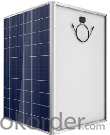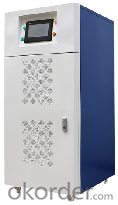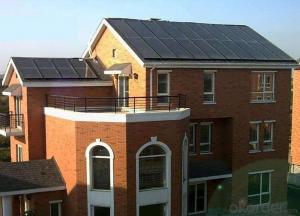20kw Solar Grid-off Power System ( 3 phase )
- Loading Port:
- China main port
- Payment Terms:
- TT OR LC
- Min Order Qty:
- 1 set
- Supply Capability:
- 500 set/month
OKorder Service Pledge
OKorder Financial Service
You Might Also Like
Item specifice
1.Technical parameters of 5kw Solar Off-grid Power System 20KW
- Solar panels
Power(Pmax): 300 Wp
Dimension: 1640x992x40 mm
Working Voltage(Voc): 39.7V
Working Current(Imp):9.32A
Weight: 20 kg
-PV Inverter with controller
Efficiency: >85%
Pure sine wave
AC 380V 50/60Hz output
Working Temp: 0℃~40℃
Battery overvoltage protection,undervoltage protection,overload protection,short circuit protection, overtemperature protection,etc.
650*570*1270mm 180KG
-Mounting Bracket
Flat roof or Ground: Galvanized steel type;
Tile roof: Aluminium type
Wind Load Resistanc: 45m/s
Snow Load: 2kN/m2
-GEL Battery of 12V 250Ah
520*269*228mm 64KG
-DC Cables
PV1-F
TUV/UL certificates
2. Product images


3. Product list
| No. | Item |
| 1 | Solar Panels |
| 2 | PV Inverter with controller built-in |
| 3 | Controller |
| 4 | Mounting racks |
| 5 | DC Cables |
| 6 | AC Cables |
| 7 | MC4 Connectors |
| 8 | GEL Battery |
| 9 | Combiner Box |
| 10 | Distribution box |
4. Remark
-In rainy days, the battery can support 3500W load work 24hours.
-The maximum power load should not exceed 18KW (including inductive load impact: such as refrigerators, air conditioners, washing machines, etc. with motor load).
-The battery can be fully charged in 5-6hours under STC sunshine condition.
5. Package
Wooden case or carton pallet packing


- Q:How do solar energy systems impact the reduction of nuclear power reliance?
- The reduction of reliance on nuclear power is greatly facilitated by solar energy systems, which offer a clean and renewable alternative. A key effect of solar energy in reducing nuclear power dependence is the substantial decrease in greenhouse gas emissions. While nuclear power plants emit virtually no carbon dioxide during operation, the processes involved in mining, refining, and transporting uranium, as well as constructing and decommissioning nuclear plants, contribute significantly to a large carbon footprint. In contrast, solar energy systems produce electricity without any direct emissions, ensuring a sustainable and environmentally friendly energy source. Additionally, solar energy systems aid in diversifying the energy mix. Relying solely on nuclear power for electricity generation poses potential safety and security risks. The Chernobyl and Fukushima disasters, for instance, have highlighted the dangers associated with nuclear power plants. By adopting solar energy systems, countries can decrease their dependence on a single energy source and mitigate the risks linked to nuclear power. Another notable impact of solar energy systems in reducing nuclear power reliance is the decentralization of energy production. Nuclear power plants are typically large-scale centralized facilities that necessitate substantial investments and long construction periods. Conversely, solar energy systems can be deployed in various scales, ranging from rooftop installations to large solar farms. This decentralization allows for a more spread out and resilient energy system, lessening the requirement for large-scale nuclear power plants. Moreover, solar energy systems provide a readily available and abundant energy resource. The sun offers an unlimited supply of energy, whereas the availability of uranium, the primary fuel for nuclear power, is limited. As uranium deposits are depleted, the cost and environmental impact of extracting and processing this resource increase. In comparison, solar energy only necessitates an initial investment in equipment and infrastructure, with relatively low operating costs. This cost-effectiveness contributes to reducing reliance on costly and finite nuclear power resources. In conclusion, solar energy systems have a significant impact on reducing reliance on nuclear power by presenting a clean, sustainable, and abundant alternative. Solar power systems minimize greenhouse gas emissions, diversify the energy mix, decentralize energy production, and utilize an infinite energy resource. Embracing solar energy enables us to decrease the risks, costs, and environmental impacts associated with nuclear power, ultimately leading to a more sustainable and secure energy future.
- Q:Can solar energy systems be used in extreme weather conditions?
- Yes, solar energy systems can be used in extreme weather conditions. While their performance may be affected by factors such as heavy rain, snow, or cloud cover, advancements in solar technology have made them more resilient and efficient in extreme weather conditions. Additionally, solar panels can be designed and installed to withstand high winds, hail, and other challenging weather conditions.
- Q:Can solar energy systems be installed in any location?
- Solar energy systems can be installed in most locations, as long as there is sufficient sunlight available. However, the efficiency and effectiveness of the system may vary depending on factors such as the amount of sunlight, shading, and the available roof or ground space for installation.
- Q:Can solar energy systems be used in powering art galleries or museums?
- Yes, solar energy systems can definitely be used to power art galleries or museums. In fact, utilizing solar power in these establishments can have numerous benefits. Firstly, art galleries and museums often have large spaces with extensive lighting systems, making them energy-intensive. Solar energy systems can provide a significant amount of electricity to power these spaces, reducing reliance on traditional energy sources and lowering operating costs. Moreover, using solar energy aligns with the environmental values often associated with art and culture. By utilizing clean, renewable energy, art galleries and museums can significantly reduce their carbon footprint and contribute to the global efforts in combating climate change. Solar energy systems can also provide a reliable source of power, especially during peak hours when galleries and museums typically experience high visitor footfall. Additionally, the installation of solar panels on the rooftops of these establishments can serve as a visual symbol of their commitment to sustainability and inspire visitors to adopt similar practices in their own lives. However, it is important to note that the feasibility of solar energy systems in art galleries or museums may vary depending on various factors such as the available roof space for solar panel installation, the geographical location, and the specific energy requirements of the establishment. Conducting a thorough assessment and feasibility study is crucial to determine the optimal size and configuration of the solar energy system for each individual gallery or museum. Overall, solar energy systems can provide a clean, renewable, and cost-effective solution for powering art galleries and museums, aligning their operations with sustainable practices while reducing their environmental impact.
- Q:Can solar energy systems be used for powering off-grid humanitarian missions?
- Yes, solar energy systems can be used for powering off-grid humanitarian missions. Solar energy is a reliable and sustainable source of electricity that can provide power to remote and isolated areas where traditional power grids are unavailable. It can be used to generate electricity for lighting, communication, medical equipment, water purification, and other essential needs in humanitarian missions. Solar energy systems are cost-effective, environmentally friendly, and can be easily installed and maintained, making them an ideal solution for off-grid power needs in humanitarian efforts.
- Q:Can solar energy systems be used in powering art galleries or museums?
- Yes, solar energy systems can definitely be used to power art galleries or museums. In fact, utilizing solar power in these establishments can have numerous benefits. Firstly, art galleries and museums often have large spaces with extensive lighting systems, making them energy-intensive. Solar energy systems can provide a significant amount of electricity to power these spaces, reducing reliance on traditional energy sources and lowering operating costs. Moreover, using solar energy aligns with the environmental values often associated with art and culture. By utilizing clean, renewable energy, art galleries and museums can significantly reduce their carbon footprint and contribute to the global efforts in combating climate change. Solar energy systems can also provide a reliable source of power, especially during peak hours when galleries and museums typically experience high visitor footfall. Additionally, the installation of solar panels on the rooftops of these establishments can serve as a visual symbol of their commitment to sustainability and inspire visitors to adopt similar practices in their own lives. However, it is important to note that the feasibility of solar energy systems in art galleries or museums may vary depending on various factors such as the available roof space for solar panel installation, the geographical location, and the specific energy requirements of the establishment. Conducting a thorough assessment and feasibility study is crucial to determine the optimal size and configuration of the solar energy system for each individual gallery or museum. Overall, solar energy systems can provide a clean, renewable, and cost-effective solution for powering art galleries and museums, aligning their operations with sustainable practices while reducing their environmental impact.
- Q:Can solar energy systems be used in areas with limited water supply?
- Yes, solar energy systems can be used in areas with limited water supply. Unlike other forms of energy generation such as fossil fuel or nuclear power, solar energy systems do not require water for their operation. Solar panels generate electricity by converting sunlight into energy without the need for water cooling or steam generation, making them ideal for areas where water resources are scarce.
- Q:Can a solar energy system power an entire home or business?
- Yes, a properly designed and sized solar energy system can power an entire home or business. The system should be tailored to the energy needs of the property, taking into account factors such as energy consumption, available roof or ground space for solar panels, and geographic location to ensure sufficient power generation. With advanced technology and efficient solar panels, it is possible to achieve energy independence and offset the majority, if not all, of the electricity requirements with solar energy.
- Q:Can a solar energy system be used in areas with high levels of dust or sand?
- Yes, a solar energy system can be used in areas with high levels of dust or sand. However, it is important to note that excessive dust or sand accumulation can reduce the efficiency of the system over time. To mitigate this, regular maintenance and cleaning of the solar panels may be required. Additionally, installing the panels at an angle or using anti-reflective coatings can help minimize the impact of dust or sand on the system's performance. Despite these challenges, solar energy systems can still be successful in these areas, especially if proper precautions and maintenance are taken.
- Q:Can solar energy systems be used for agricultural irrigation?
- Yes, solar energy systems can be used for agricultural irrigation. Solar-powered water pumps and irrigation systems are becoming increasingly popular and cost-effective, enabling farmers to harness renewable energy to pump water from wells, rivers, or reservoirs for crop irrigation. This reduces reliance on fossil fuels and helps mitigate environmental impacts while providing a sustainable solution for agricultural water needs.
1. Manufacturer Overview |
|
|---|---|
| Location | |
| Year Established | |
| Annual Output Value | |
| Main Markets | |
| Company Certifications | |
2. Manufacturer Certificates |
|
|---|---|
| a) Certification Name | |
| Range | |
| Reference | |
| Validity Period | |
3. Manufacturer Capability |
|
|---|---|
| a)Trade Capacity | |
| Nearest Port | |
| Export Percentage | |
| No.of Employees in Trade Department | |
| Language Spoken: | |
| b)Factory Information | |
| Factory Size: | |
| No. of Production Lines | |
| Contract Manufacturing | |
| Product Price Range | |
Send your message to us
20kw Solar Grid-off Power System ( 3 phase )
- Loading Port:
- China main port
- Payment Terms:
- TT OR LC
- Min Order Qty:
- 1 set
- Supply Capability:
- 500 set/month
OKorder Service Pledge
OKorder Financial Service
Similar products
New products
Hot products
Hot Searches
Related keywords





























